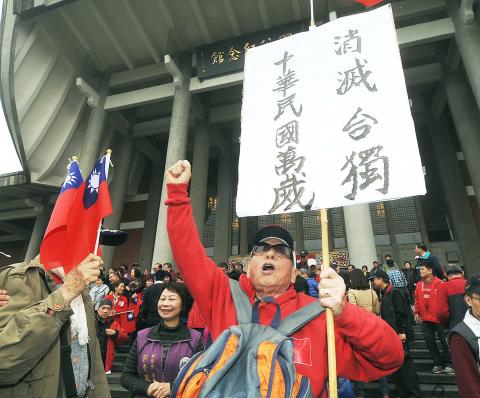“Brutal anti-democratic” acts that defaced a statue of the nation’s founding father cannot erase the fact that Taiwan shares a deep history with Sun Yat-sen (孫逸仙) and the Chinese revolution, President Ma Ying-jeou (馬英九) said yesterday.
Many people in Taiwan had helped repatriate Taiwan to the Republic of China (ROC), such as Lien Chen-tung (連震東), Hsieh Tung-min (謝東閔) and Lee You-pang (李友邦), Ma said at a ceremony in Taipei commemorating the 89th anniversary of Sun’s death.
Eighteen delegates from Taiwan attended the 1946 People’s Assembly to ratify the ROC Constitution, and numerous Taiwanese had also helped in campaigns launched by former president Chiang Kai-shek (蔣介石) during the Second Sino-Japanese War, all of which illustrate the bond Taiwan shares with Sun’s revolution, Ma said.

Photo: Fan Pin-chao, Taipei Times
Large portraits of Taiwanese who have fought for the nation, including Chiang Wei-shui (蔣渭水), Monaludo (莫那魯道), Lo Fu-hsing (羅福星) and Liao Chin-ping (廖進平) have also hung outside the KMT’s headquarters since Ma’s first term as KMT chairman in 2005.
“We are always thankful for what these forerunners of democracy did for Taiwan,” Ma said.
His comments were seen as a rebuke to Alliance of Referendum for Taiwan members who, led by alliance convener Tsay Ting-kuei (蔡丁貴), toppled a statue of Sun in the center of a Greater Tainan park on Feb. 23, saying it had a damaged base and posed a risk to public safety.
Pro-localization groups had complained that the statue overshadowed the commemorative bust of 228 Incident hero Tang Te-chang (湯德章), for whom the park is named.
Ma said he wondered how those who toppled the statue “could face Chiang Wei-shuei, who is commonly called the “Sun Yat-sen of Taiwan” after such act of “anti-democratic brutality.”
Another commemorative event for Sun was held by the New Party and other organizations to back calls for the Greater Tainan Government to address the incident.
Such an incident should not have happened in a democratic country, New Party Chairman Yok Mu-ming (郁慕明) said.
Yok said Sun’s statue must be restored and that there would be demonstrations if action was not taken.
China Unification Promotion Party leader Chang An-le (張安樂) also protested what he said was a lack of action by the Greater Tainan Government.
He visited the park yesterday to pay his respects at the site and shouted a round of slogans.
He then gave Tainan Secretariat Secretary-General Hsiao Po-jen (蕭博仁) a letter of complaint.
Meanwhile, the Filipino Chinese Cultural and Economic Association and the Sun Yat-sen Society in the Philippines paid for a notice in Chinese-language newspapers yesterday that condemned the alliance for downing Sun’s statue.
“We roundly condemn the barbaric act that has angered all Chinese compatriots in the country and abroad,” the notice said, adding that the act was a “release of barbarism by people walking into the dead end of Taiwanese independence.”
The two organizations called for the alliance members involved to apologize publicly and to have the statue repaired.

An essay competition jointly organized by a local writing society and a publisher affiliated with the Chinese Communist Party (CCP) might have contravened the Act Governing Relations Between the People of the Taiwan Area and the Mainland Area (臺灣地區與大陸地區人民關係條例), the Mainland Affairs Council (MAC) said on Thursday. “In this case, the partner organization is clearly an agency under the CCP’s Fujian Provincial Committee,” MAC Deputy Minister and spokesperson Liang Wen-chieh (梁文傑) said at a news briefing in Taipei. “It also involves bringing Taiwanese students to China with all-expenses-paid arrangements to attend award ceremonies and camps,” Liang said. Those two “characteristics” are typically sufficient

A magnitude 5.9 earthquake that struck about 33km off the coast of Hualien City was the "main shock" in a series of quakes in the area, with aftershocks expected over the next three days, the Central Weather Administration (CWA) said yesterday. Prior to the magnitude 5.9 quake shaking most of Taiwan at 6:53pm yesterday, six other earthquakes stronger than a magnitude of 4, starting with a magnitude 5.5 quake at 6:09pm, occurred in the area. CWA Seismological Center Director Wu Chien-fu (吳健富) confirmed that the quakes were all part of the same series and that the magnitude 5.5 temblor was

The brilliant blue waters, thick foliage and bucolic atmosphere on this seemingly idyllic archipelago deep in the Pacific Ocean belie the key role it now plays in a titanic geopolitical struggle. Palau is again on the front line as China, and the US and its allies prepare their forces in an intensifying contest for control over the Asia-Pacific region. The democratic nation of just 17,000 people hosts US-controlled airstrips and soon-to-be-completed radar installations that the US military describes as “critical” to monitoring vast swathes of water and airspace. It is also a key piece of the second island chain, a string of

The Central Weather Administration has issued a heat alert for southeastern Taiwan, warning of temperatures as high as 36°C today, while alerting some coastal areas of strong winds later in the day. Kaohsiung’s Neimen District (內門) and Pingtung County’s Neipu Township (內埔) are under an orange heat alert, which warns of temperatures as high as 36°C for three consecutive days, the CWA said, citing southwest winds. The heat would also extend to Tainan’s Nansi (楠西) and Yujing (玉井) districts, as well as Pingtung’s Gaoshu (高樹), Yanpu (鹽埔) and Majia (瑪家) townships, it said, forecasting highs of up to 36°C in those areas